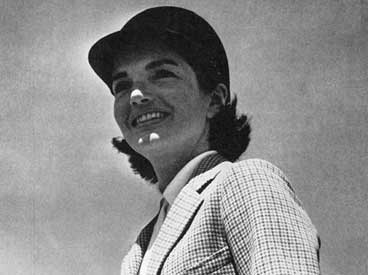This is the sixth installment of our series “Reconstructing Kennedy.”

Hollywood couldn’t have dreamed up two better characters than John and Jacqueline Kennedy to portray America’s ideal, romantic couple. She was elegant, poised, and incredibly well dressed. He was the newly elected president of the United States. Young, sophisticated and good looking, they seemed like the polar opposites of the previous residents of the White House, Dwight and Mamie Eisenhower. The Kennedy’s attractiveness quotient rose even higher just two weeks after the election when Jacqueline gave birth to a son.
Many Americans only got their first look at Jackie during the inaugural ceremonies. She’d remained at home during the campaign under her obstetrician’s order, though she was still giving interviews, taping TV commercials, and writing a weekly newspaper column called “Campaign Wife.”
In the following months, Americans read about the dazzling receptions she hosted, how she put international visitors at ease with her command of French and Spanish, and even got on the good side of Soviet premier Nikita Khrushchev. Newspapers and magazines also ran stories on Jackie’s wardrobe and her French-influenced look. Copies by several domestic designers soon appeared on American women across the country.

But Jackie made her most memorable impression as first lady in 1962, when she conducted a televised tour through the recently refurbished White House.
The makeover had been sorely needed. As the Post reported in 1963 (“How Jackie Restyled the White House”), President Truman had ordered massive renovations to the White House’s structure in 1945 to prevent the building from collapsing. But the interior design had been an afterthought, entrusted to a hotel contractor who gave the rooms a bland, institutional look. One Washington reporter wrote, “The White House is safe, all right, but it has completely lost its charm. The restoration took the heart out of the building…Now it has no more appeal than the Pentagon.”
Arriving at the White House, the Kennedys discovered most of the furnishings dated back only as far as 1902. The paintings were all forgettable works that previous presidents hadn’t bothered to take with them when they left.
What Jackie proposed was more than just a refurnishing. Her intention was to build a collection of White House furnishings that would reflect the long heritage of American design. Under her direction, the Executive Mansion acquired 500 items of furniture and art. Some were former White House furnishings that she bought back from private ownership. Many other items came from wealthy collectors, but several were donated from average Americans who offered up their antique silverware, wallpaper, and chamber pots. When completed, the collection was protected by a law, proposed by Jackie, that would forbid the removal of any items from the White House.

The tour of the completed project was televised on February 14 when Jackie showed the new acquisitions and explained how each room was furnished in the style of a different era. The Lincoln room, for example, contained only furniture of the Civil War period and included Lincoln’s own portrait of Andrew Jackson and a table purchased by his wife, Mary. Jackie was seen that night by over 80 million Americans.
Jackie made her most enduring impression when she was no longer first lady. She remained in the public eye from the death of her husband right up to his burial at Arlington Cemetery. Throughout that time, she displayed a fortitude and courage that few had suspected in her.
Looking back at articles about her in the Post, it’s surprising to see how good a job she did as first lady even though it was a job she never wanted. Interviewed for the Post by an old friend (“An Exclusive Chat With Jackie Kennedy”), she admitted to a chronic shyness. “I can’t stand being out in front. I know it sounds trite, but what I really want is to be behind [John] and to be a good wife and mother.”
It wouldn’t have surprised John Kennedy. His wife had always impressed him with her quiet strength. Years earlier, he told a friend, “My wife is a shy, quiet girl, but when things get rough, she can handle herself pretty well.”
It’s no surprise that even today, Jacqueline Bouvier Kennedy remains an icon in American history.
Become a Saturday Evening Post member and enjoy unlimited access. Subscribe now



